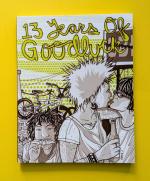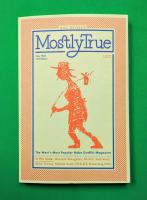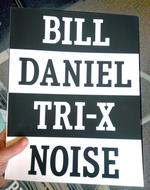
Who is Bozo Texino?
by Bill Daniel Author
Beginning work around 1982, Bill Daniel set out to explain traveling hobo culture and the origins of the mysterious freight train tag of "Bozo Texino", a person wearing a cowboy hat with a pipe. "Who is Bozo Texino?" is a film study on the 100-year-old tradition of hobo and rail worker graffiti. Mostly shot on freight trips across the western US, the film includes interviews with some of the railroad’s greatest graffiti legends: Colossus of Roads, The Rambler, Herby (RIP) and the granddaddy of them all, Bozo Texino. The film also catches some of the socio-economic history of hobo subculture from its roots after the Civil War to the present day. Included are interviews with tramps that Daniel encountered in his travels. The range of the interviews, and the film’s style deal with both the clichés and the harsh realities of tramp life. In researching hobo culture Daniel found the written histories fraught with myth, and was initially frustrated by the apparent lack of verifiable truth to much of the lore. What we are left with is a fascinating little window capturing a slim view of the lifestyle, the nature of tagging, and the mysterious long standing tradition of the seemingly larger-than-life Bozo Texino. Read an interview on Fall of Autumn! and another interview on Cinemad!
Don't forget to pick up Bill Daniel's companion book about hobo culture and train graffiti, Mostly True.
Who is Bozo Texino? Trailer from T2B on Vimeo.
You must log in to comment.




Comments & Reviews
" ... the film boasts a terrific physical beauty and a truly quirky feel."
"THE FIRST THING you notice about Bill Daniel's Who Is Bozo Texino? is its free spirit. One minute, Daniel's calibrated edits make the side of a passing train car resemble a fluttering flag or a pack of cards being shuffled. The next, he's training his black-and-white photographic vision on some marble-mouthed, bearded tramps and their campsite, and you couldn't be blamed for thinking the year was 1936. The wandering eye of Daniel's film perfectly suits (to borrow its subtitle) The Epic Tale of the Improbable Discovery of the True Identity of the World's Greatest Boxcar Artist. As the filmmaker hunts the man behind Bozo – whose figure-eight cowboy hat graces boxcars across the country – he's sidetracked into encounters with characters bearing monikers as plain as Road Hog and as poetic as Colossus of Roads. Flashes of interstate momentum shift to yakky philosophical idylls, all according to whim. "
"Shooting over a 16-year period, Daniel rode freights across the West carrying a Super-8 sound camera and a 16mm Bolex. During his quest he discovered the roots of a folkloric tradition that has gone mostly unnoticed for a century. Taking inspiration from Beat artists Robert Frank and Jack Kerouac, the film functions as both a sub-cultural documentary and a stylized fable on wanderlust and outsider identity. I was drawn to the subject by the universal graffiti impulse and the classic, corny notion of freight train blues escape."
""Cinematographic song of praise to the self-imposed life of a hobo. Using a 16mm and a Super8 camera, Bill Daniel collected images of the hobo subculture over a period of about 15 years. His years of roaming in goods trains brought him into contact with countless legendary hobos. Daniel links their stories and visions of life to their "tags", the signs they left on trains long before graffiti was any kind of a hype. The film focuses on the quest for the eminent Bozo Texino, whose tag decorated trains all over the country for 80 years. In beautiful black & white, to the rhythm of train wheels and country music, Daniel portrays passionate people who have turned away from the establishment and it's rules."
" A hypnotic, rail-rattling tone poem of subversive wayfarer wisdom-- as revealed through the witty, artfull, unexpected delights of railroad graffiti."
" ... gorgeous and effecting ... "
"Bill Daniel’s fascinating documentary Who Is Bozo Texino? delves into the hobo subculture with an inquisitive, romantic verve.
Just don’t expect a PBS-styled infotainment. Shot entirely on black-and-white film, Bozo is more akin to sensory immersion, plunging you into this world from the get-go. Daniel interviews hobos in train yards, on moving cars, on the side of the tracks, wherever, as his camera catches scenery ripping by as seen from a boxcar, the whir of tracks underneath the cars, smiling faces and waves as trains pass by."
"Bill Daniel is an artist known for his advantageousness, and “Who Is Bozo Texino?” exhibits that vigor. This film documents Daniel’s 16-year journey to trace the history behind a graffiti symbol”"a sketch of a man who sports a hat and the moniker “Bozo Texino,”"”found scrawled on railcars for over 80 years.
Daniel’s search unveils a secret society of hobo and rail worker graffiti artists. To see as they saw, Daniel films rural and urban American landscape from moving boxcars. Additionally, the stunning black and white film contains interviews with contemporary boxcar artists."
"In 1987 Daniel and his trusty Bolex camera began hanging out in hobo jungles and riding freights across the West, looking for clues to the identity of a strange boxcar graffito. While gathering interviews and discovering clues to the identities of many of the most legendary boxcar artists, Daniel discovered a vast underground folkloric practice that has existed with little notice for over a century. Today these drawings live on as a new breed of hobos have taken to the rails and kept the tradition of "moniker chalking" alive. This artform provides unlikely common ground between mostly conservative railworkers and old school tramps and the kids whose approach includes spray cans and punk lifestyles."
"Who is Bozo Texino? is a rare 56 minute B&W experimental doc that searches for the source of this rail graffiti writer, known only by his ubiquitous moniker. In the film, Bill Daniels hunts down this elusive fellow who compulsively scrawled his tag name, “Bozo Texino” as a character of a man with an infinity-shaped hat–a drawing seen on railcars for over 80 years! More than just a character study of this aging nomad, the doc also explores the little known facts surrounding the hobo culture."
"This is an excellent documentary in black and white whose subject is the lives of the railroad hobos, and more specifically, the grafitti they use to mark their "monikers" on the trains they ride. The filmaker has managed to get these hobos, outsiders to society, to open up and talk about their lives and shows them marking the trains with their graffitti as they talk about their unusual culture. Shot with hand held camera, the photography is excitingly beautiful, much of it filmed from inside or on top of the boxcars as they speed by beautiful western vistas and funky rail yards."
"Who is Bozo Texino is a wonderful journey into the world of hoboes past and present. It documents in gritty, monochromatic 16mm beauty, the passing of a generation's history and the birth of another. What starts as a quest for hobo writing's origin, turns into an hommage to a defiant subculture with its own rules, ethics and methods of communication. Woven with railroad sounds, folk song and verbal textures, Bill Daniel discovers the nobility of the past hobo culture and defines the fracturing of it by a new generation of riders who have lost cohesion. The brotherhood of the rail lives on, and through this film, it's ethics and soul may also survive."
"Daniel's carefully crafted documentary looks back to the birth of the hobo subculture that arose following the Civil War while touching on the socioeconomic history of the lifestyle and showcasing interviews with a variety of well-known graffiti legends including The Rambler, Colossus of Roads, and, of course, Bozo Texino. Whether dealing with the colorful clichés or the sometimes harsh realities of the hobo movement, this look at the century-old folkloric practice seeks to preserve a pivotal piece of American history so that future generations will know just what life on the rails was really all about."
"By documenting the remnants of a subculture for whom the slogan "Live free or die" is something other than license plate trim, Bill Daniel reminds us that there once was a time when homelessness wasn't a problem but a choice, and finding work was as easy as hopping the next westbound train."
"In his work, Daniel is attracted to outsiders in the most literal sense -- people who live on the outside of civilization, for whom, in Daniel's eyes, mere survival is an act of artistic expression."
Interview on Fall of Autumn!
I'm not going to hold back any enthusiasm...this is the best movie I've ever seen.
Bill Daniel's homegrown epic is as kinetic and raggedly beautiful as the trains he hopped to mae it. Using the search for the origin of a near mythical example of railroad graffiti as a point of departure, Bill made a flim about freedom as literal passage across the land. Corporations brand things to say they own them, but there are ways in which humans have marked things to say they can't be owned.
Daniel places himself firmly in the bootprints of Jack London, Jack Kerouac, Walt Whitman, Woody Guthrie - a fine, long tradition of American artists who look for their inspiration to the marginal, the underclass, the vagabond and the outcast. Nominally a chronicle/survey/history of boxcar graffiti (a tradition as old as the railroad itself) and the men who create it, Who Is Bozo Texino? soon transcends its narrow subject-matter to become a gloriously rough-edged elegy for an America which is being swept away before our eyes.
At a certain point in research and filming, I had to give up on the idea of being able to tell every story down to the detail. One of my initial impulses was to create a highly resolved document that would allow people in the future to see exactly what this culture was like. But at the same time I was painfully aware that to broadcast these discoveries would alter or wreck the innocence and freedom that was there. Gradually, I realized that to report on freight train culture I should just acknowledge this mythologizing that permeates the culture and adopt that as an essential part of my approach. But the difficulty was, at the same time, to present this purely documentary material that I earnestly want to be appreciated and preserved. And no matter what the disappointment might be in finding the lonely reality behind a particular myth or graffiti, there is a mystery, or truth, that will always evade the documentarian and the audience.